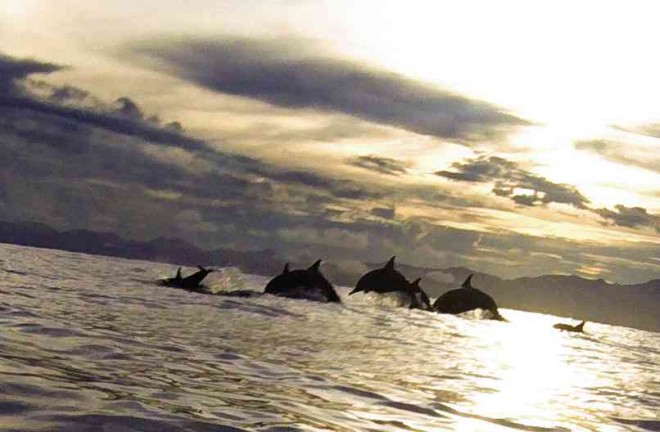Dolphins stage special show in Antique

DOLPHINS seemingly dance in the waters off Tibiao, Antique province. FLORD NICSON CALAWAG/INQUIRER VISAYAS
TIBIAO, Antique—For newlyweds Vophie and Evone Pendon, it was a special show that elicited screams of delight while they were on a honeymoon boat tour to Seco Island’s white, powdery sand in Tibiao, Antique province.
Three dolphins jumped just in front of their boat more than an hour after they left Tibiao mainland. Minutes later, 20 to 40 dolphins simultaneously danced through the waves. “What’s more mesmerizing was when the two dolphins started to flip above the water,” Evone said.
“This is my first time to have a close encounter with so many dolphins here in Panay,” her husband said.
Locally known as rumbà-rumbà, the Gray’s spinner dolphin (Stenella longirostris) is one of the 26 species of cetaceans in the Philippines. They can be seen spinning high in the air (hence its common name) or riding the bow waves of boats.
Also known as long-beaked or long-snouted dolphins, they usually feed at night on small fish and squid. According to noted dolphin expert Kenneth S. Norris, “divergence zones at current margins and current ridges which both concentrate food organisms are heavily frequented by dolphins.” They can dive up to 984 feet or 300 meters to get food.
Article continues after this advertisementFemales reach sexual maturity at 4-7 years and males, 7-10 years. Gestation period lasts 10.5 months, and calves are nursed for one to two years.
Article continues after this advertisementFisherman Jenny Barrientos, who chairs the Municipal Fisheries and Aquatic Resources Management Council of Tibiao, often sees the dolphins while on duty as “bantay-dagat” (sea patrol) enforcer off Seco Island.
“We are giving due respect to the rumbà-rumbà and the pawikan because they are part of our ecosystem. This is one of the reasons why I am committed to save our seas because I am personally happy to see them in wild,” Barrientos said.
“I also want my children to experience what I have seen,” he said.
Gentle creatures
Another fisherman, Mario Arsaga, said “they are gentle creatures and are fun to watch as they jump in the water. They have been helpful to us when we go fishing because once they are around, it means there are a lot of tunas in the fishing ground.”
“Rumbà-rumbà always swim in front of our boats as we go fishing at night. Once they are there, it is an indicator that we have a good catch,” said Felipe Soriaga, a fisherman from Patnongon.
Though Gray’s spinner dolphin is classified as “data deficient” on the International Union for Conservation of Nature Red List, and listed on Appendix II of the Convention on International Trade in Endangered Species of Wild Fauna and Flora, local government officials of Antique are on high alert to protect the valuable species.
Major threats
It is illegal to take or catch, sell, purchase, possess, transport and export dolphins, whales and porpoises in the Philippines. Dolphins and all cetaceans are protected in the Philippines under the Fisheries Administrative Order No. 185, No. 185-1 and No. 208, the Fisheries Code, the Wildlife Act, and the Animal Welfare Act.
The major threats come from hunting, getting caught in fishing net accidentally, pollution and degradation of habitat.
“Our sea patrol in the municipality of Culasi is closely monitoring all marine activities including the protection of the rumbà-rumbà or dolphins and other endangered marine wildlife, including whale sharks, dugong, manta ray and pawikan,” Mayor Joel Lumogdang said.
A pod of dolphins is commonly seen between Batbatan Island of Culasi and Seco. That body of water is part of Cuyo East Pass, a rich fishing ground and known as a highway of migratory species.
“Since we declared Seco Island as Marine Protected Area last year, we have intensified our bantay-dagat program to fully enforce the necessary regulations to protect our marine biodiversity. In this way, we can restore the balance of our marine life,” said Mayor Gil Bandoja of Tibiao.
Vophie Pendon, technical assistant of the Biodiversity Partnerships Project under the DENR regional office commended the efforts and initiatives of the local governments in protecting and conserving municipal waters.
“This is my first time to have a close encounter with so many dolphins here in Panay Island,” he said. “The best experience is to see them in the wild and to know that there is a strong political will from the local government units to save them.”
John Sumanting, a tourism officer of Culasi, said the municipality would include dolphin watching as a natural attraction.
“You need to experience dolphins in their natural habitat to be able to understand and appreciate them fully. This is the best and only way to enjoy dolphins. However, we want to make sure first that necessary regulations are in place so as not to disturb their natural habitat and behavior. We are for sustainable tourism,” Sumanting said.
One of the tourists who went to Seco documented his encounter with the dolphins in his blogs.
“When we were halfway across the sea, we saw a school of dolphin swimming not far from our boat. We thought they were just one group but lo and behold, as we got near them lots were jumping around! A pod of dolphin was swimming around us! It was so cool!!!” blogger Ruthieliza said.